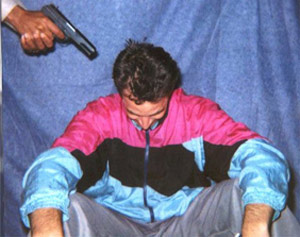|
The Danny Pearl Death Tape
Should everyone watch the grisly death of Wall Street
Journal reporter Daniel Pearl?
By JAMES PONIEWOZIK

CNN/AP Wall
Street Journal reporter Daniel Pearl with a gun to his head
|
 | 
Saturday, Jun. 08, 2002
Can anyone
possibly recommend watching the video of Daniel Pearl’s murder? On
it, the terrorists who abducted the Wall Street Journal reporter in
Pakistan force him to declare his Jewish heritage and condemn the
U.S. government; they then saw the head off his limp body and
brandish it while a list of demands scrolls up the screen. It is
awful, evil, dehumanizing. But does that mean it’s not also a part
of history? Last week a weekly newspaper declared that it was. The
Boston Phoenix provided a link to the footage from its Web page and
showed Pearl’s decapitated head in its print edition. (In May, CBS
News aired non-gruesome segments.) Seeing the video, wrote the
Phoenix’s publisher, "should galvanize every non-Jew hater in the
world." Many media critics called the link a cruel stunt with no
public benefit. The Pearl family was unequivocal: Those who share
the video, they said, "fall without shame into the terrorists’
plan."
Daniel Pearl was an innocent civilian whose family never
volunteered for the spotlight. So were the victims of 9/11. But the
debate over their images started as soon as the airplanes struck the
World Trade Center. HBO’s recent documentary In Memoriam used
amateur video to chronicle Sept. 11; as someone jumps to escape the
flames, a voice off camera lectures, "Don’t take pictures of that!
What’s the matter with you?" Former New York City Mayor Rudolph
Giuliani defended the images, arguing that we have not only a right
but an obligation to watch, so as not to sanitize our collective
memory.
What distinguishes a snuff film from a historical document?
Showing crime-scene photos from a murder-rape adds nothing to the
public discourse. The media chose not to print death photos of
Princess Diana, and we were none the poorer. But there are
exceptions. The Nazis’ victims stacked in mounds, the Viet Cong
executed with a gunshot to the head, the dead at Kent State and in
Rwanda all had families and a human right to dignity. But their
deaths had an unfortunate significance for the world; they were
conscripted into history in a way that someone knifed in an alley is
not. Yes, we would still know what happened to them even if we
destroyed every picture of their deaths. But would we feel it?
Jacqueline Kennedy knew the power of image when she insisted on
returning to Washington wearing the clothes stained with her
husband’s blood: she said, "I want them to see what they have done."
She, unlike Pearl’s family, made her own choice. But Pearl’s
murder too was an assassination, aimed at his country and his
ethnicity. And the video is not simply raw footage of violence — the
beheading scene is only a couple of seconds long — but a produced
propaganda tape. Intercut with Pearl’s statement are war scenes from
the Palestinian territories: an injured baby, Israeli soldiers.
Using Muslim grievances to justify slaughtering a Jewish civilian
should be insulting to all those whom the terrorists want to co-opt.
But it evidently is not, given the terrorists’ continuing ability to
win recruits. We may already know that intellectually. But the video
makes this noxious logic searingly real. I sweated through every
moment of watching the damned thing. I paused it every few seconds
and paced, checked my e-mail, went downstairs to kiss my baby son —
anything to avoid it. I felt sick and angry — at the killers, the
Phoenix, myself.
Here is where, I suppose, I should tell you whether to watch the
video. But I won’t. We feel compelled to cast judgments about
viewing images of terror because terrorism seeks to make us feel
powerless, and taking an absolutist stance — Don’t look at that! You
owe it to the dead to look at that! — is a way of reasserting
control. To say that there is some value in looking, but no shame in
averting your eyes, places one in that squishy gray area in which we
have to live. Having watched the video, am I better informed about
the hatred behind the killing? A little. Am I somehow a better
person for it? I doubt it. Should you watch as well? I have no idea.
Because images operate on an emotional level, no one can predict
their effect — and that is scary. No one knows if the Pearl video
will do more to rally the terrorists or us, whether seeing bodies
falling from the towers will numb people or combat complacency. The
Pearl video is the Zapruder film of terrorism, footage that will
rightly carry a taboo and not many will want to see. But it would be
hubris to decide that because I wish I had never seen it, you never
should — that I can’t trust you to watch it for the right reasons or
to draw the right lessons. If Daniel Pearl were here today, he might
disagree. Daniel Pearl is not here today. He was murdered to send
you a message. How to receive that message, and what to do next,
must be your choice.
|